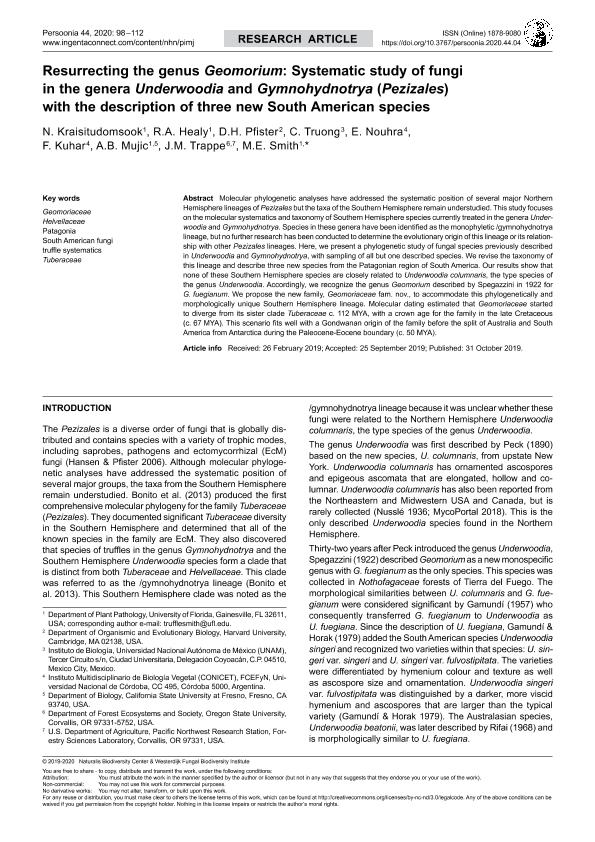Mostrar el registro sencillo del ítem
dc.contributor.author
Kraisitudomsook, N.
dc.contributor.author
Healy, R .A.
dc.contributor.author
Pfister, D. H.
dc.contributor.author
Truong, Camille

dc.contributor.author
Nouhra, Eduardo Ramon

dc.contributor.author
Kuhar, José Francisco

dc.contributor.author
Mujic, A. B.
dc.contributor.author
Trappe, J. M.
dc.contributor.author
Smith, María Emilia

dc.date.available
2020-08-06T19:03:43Z
dc.date.issued
2020-06
dc.identifier.citation
Kraisitudomsook, N.; Healy, R .A.; Pfister, D. H.; Truong, Camille; Nouhra, Eduardo Ramon; et al.; Resurrecting the genus Geomorium: Systematic study of fungi in the genera Underwoodia and Gymnohydnotrya (Pezizales) with the description of three new South American species; Naturalis Biodiversity Center; Persoonia; 44; 635; 6-2020; 98-112
dc.identifier.issn
0031-5850
dc.identifier.uri
http://hdl.handle.net/11336/111079
dc.description.abstract
Molecular phylogenetic analyses have addressed the systematic position of several major Northern Hemisphere lineages of Pezizales but the taxa of the Southern Hemisphere remain understudied. This study focuses on the molecular systematics and taxonomy of Southern Hemisphere species currently treated in the genera Underwoodia and Gymnohydnotrya. Species in these genera have been identified as the monophyletic /gymnohydnotrya lineage, but no further research has been conducted to determine the evolutionary origin of this lineage or its relationship with other Pezizales lineages. Here, we present a phylogenetic study of fungal species previously described in Underwoodia and Gymnohydnotrya, with sampling of all but one described species. We revise the taxonomy of this lineage and describe three new species from the Patagonian region of South America. Our results show that none of these Southern Hemisphere species are closely related to Underwoodia columnaris, the type species of the genus Underwoodia. Accordingly, we recognize the genus Geomorium described by Spegazzini in 1922 for G. fuegianum. We propose the new family, Geomoriaceae fam. nov., to accommodate this phylogenetically and morphologically unique Southern Hemisphere lineage. Molecular dating estimated that Geomoriaceae started to diverge from its sister clade Tuberaceae c. 112 MYA, with a crown age for the family in the late Cretaceous (c. 67 MYA). This scenario fits well with a Gondwanan origin of the family before the split of Australia and South America from Antarctica during the Paleocene-Eocene boundary (c. 50 MYA).
dc.format
application/pdf
dc.language.iso
eng
dc.publisher
Naturalis Biodiversity Center
dc.rights
info:eu-repo/semantics/openAccess
dc.rights.uri
https://creativecommons.org/licenses/by-nc-sa/2.5/ar/
dc.subject
FUNGI
dc.subject
ECTOMYCORRYZAL
dc.subject
PATAGONIA
dc.subject
PEZIZALES
dc.subject.classification
Micología

dc.subject.classification
Ciencias Biológicas

dc.subject.classification
CIENCIAS NATURALES Y EXACTAS

dc.title
Resurrecting the genus Geomorium: Systematic study of fungi in the genera Underwoodia and Gymnohydnotrya (Pezizales) with the description of three new South American species
dc.type
info:eu-repo/semantics/article
dc.type
info:ar-repo/semantics/artículo
dc.type
info:eu-repo/semantics/publishedVersion
dc.date.updated
2020-07-20T15:52:25Z
dc.identifier.eissn
1878-9080
dc.journal.volume
44
dc.journal.number
635
dc.journal.pagination
98-112
dc.journal.pais
Países Bajos

dc.journal.ciudad
Leiden
dc.description.fil
Fil: Kraisitudomsook, N.. University of Florida; Estados Unidos
dc.description.fil
Fil: Healy, R .A.. University of Florida; Estados Unidos
dc.description.fil
Fil: Pfister, D. H.. Harvard University; Estados Unidos
dc.description.fil
Fil: Truong, Camille. Universidad Nacional Autónoma de México; México
dc.description.fil
Fil: Nouhra, Eduardo Ramon. Consejo Nacional de Investigaciones Científicas y Técnicas. Centro Científico Tecnológico Conicet - Córdoba. Instituto Multidisciplinario de Biología Vegetal. Universidad Nacional de Córdoba. Facultad de Ciencias Exactas Físicas y Naturales. Instituto Multidisciplinario de Biología Vegetal; Argentina
dc.description.fil
Fil: Kuhar, José Francisco. Consejo Nacional de Investigaciones Científicas y Técnicas. Centro Científico Tecnológico Conicet - Córdoba. Instituto Multidisciplinario de Biología Vegetal. Universidad Nacional de Córdoba. Facultad de Ciencias Exactas Físicas y Naturales. Instituto Multidisciplinario de Biología Vegetal; Argentina
dc.description.fil
Fil: Mujic, A. B.. University of Florida; Estados Unidos
dc.description.fil
Fil: Trappe, J. M.. University of Florida; Estados Unidos
dc.description.fil
Fil: Smith, María Emilia. Consejo Nacional de Investigaciones Científicas y Técnicas. Oficina de Coordinación Administrativa Houssay. Instituto de Nanobiotecnología. Universidad de Buenos Aires. Facultad de Farmacia y Bioquímica. Instituto de Nanobiotecnología; Argentina
dc.journal.title
Persoonia

dc.relation.alternativeid
info:eu-repo/semantics/altIdentifier/url/https://www.ingentaconnect.com/content/10.3767/persoonia.2020.44.04
dc.relation.alternativeid
info:eu-repo/semantics/altIdentifier/doi/http://dx.doi.org/10.3767/persoonia.2020.44.04
dc.relation.alternativeid
info:eu-repo/semantics/altIdentifier/url/https://www.ncbi.nlm.nih.gov/pmc/articles/PMC7567970/
Archivos asociados
